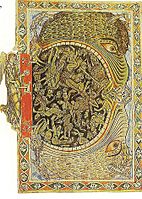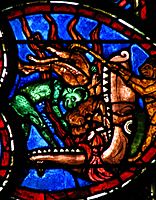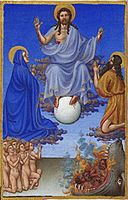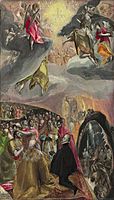Hellmouth facts for kids

A Hellmouth is like the entrance to Hell, imagined as the wide-open mouth of a giant monster. This scary image first appeared in Anglo-Saxon art in England. It then became popular all over Europe. You could often see it in paintings and artworks about the Last Judgment (when people are judged after death) and the Harrowing of Hell (when Jesus rescued souls from Hell). This image was very common until the end of the Middle Ages. It was even used sometimes during the Renaissance and later.
The Hellmouth became popular again in printed pictures after the Protestant Reformation. These pictures often showed people from the opposing side disappearing into the monster's mouth. A famous artist named El Greco included a Hellmouth in two of his paintings around 1578. Even Political cartoons showed leaders like Napoleon leading his soldiers into one.
During the Middle Ages, plays often used a Hellmouth as a special stage prop. This mechanical device was meant to scare the audience by showing a dramatic entrance to Hell. These stage Hellmouths sometimes looked like a castle entrance with battlements, which in paintings were usually linked to Heaven.
The main idea behind the Hellmouth was to remind Christian people about the danger of damnation (being sent to Hell). People shown going into or already inside the Hellmouth were usually naked. This was because their clothes were not thought to survive the `General Resurrection of the Dead`, which was often part of the same artwork. Some naked figures still wore hats or headgear that showed their high rank in society. The most common ones were the papal tiara (for the Pope), a king's crown, and a bishop's mitre. It was much rarer to see signs that someone was not Christian, like a Jewish hat.
Contents
What is a Hellmouth?
A Hellmouth is a powerful symbol. It shows the entrance to Hell as a terrifying, gaping mouth of a huge beast. This image was used to teach people about good and evil. It also reminded them about the consequences of their actions.
How the Hellmouth Symbol Developed
The very first known example of an animal Hellmouth is an ivory carving from around the year 800. An expert named Meyer Schapiro noted that most early examples before the 12th century came from England. Many of these early artworks showed the `Harrowing of Hell`. This story, where Christ successfully raided Hell, was very popular with the Anglo-Saxons.
Schapiro thought that the Hellmouth image might have come from an old pagan myth called the `Crack of Doom`. In this myth, a giant wolf-monster named Fenrir was slain by the god Vidar. Vidar was sometimes used as a symbol for Christ in art from the Anglo-Scandinavian period, like on the Gosforth Cross. When Vikings in northern England became Christian, the Church was surprisingly open to mixing pagan images with Christian ones. You can see this on `hogback` grave markers, for example.
Satan as a Swallowing Dragon
In old Anglo-Saxon writings called the `Vercelli Homilies`, Satan is described like a dragon that swallows people who are damned. One passage says:
... they never come out of the pit of snakes and of the throat of the dragon which is called Satan.
This shows how the idea of a monster swallowing people was already present.
Connecting to the Leviathan
The giant whale-monster Leviathan is mentioned in the Book of Job in the Hebrew Bible. Some people have linked the Hellmouth to this creature. It's hard to be sure about this in the very earliest artworks. However, an Old English poem called The Whale clearly compares the mouth of Hell to a whale's mouth:
The whale has another trick: when he is hungry, he opens his mouth and a sweet smell comes out. The fish are tricked by the smell and they enter into his mouth. Suddenly the whale's jaws close. Likewise, any man who lets himself be tricked by a sweet smell and led to sin will go into hell, opened by the devil—if he has followed the pleasures of the body and not those of the spirit. When the devil has brought them to hell, he clashes together the jaws, the gates of hell. No one can get out from them, just as no fish can escape from the mouth of the whale.
This poem shows how the idea of a giant mouth trapping souls was used to teach moral lessons.
Linking to Cerberus
Later in the Middle Ages, the mythical three-headed dog Cerberus from Greek and Roman stories also became connected to the Hellmouth image. However, it's unlikely the Anglo-Saxons knew about Cerberus when the Hellmouth idea first started.
Is the Hellmouth Satan's Mouth?
Sometimes, Satan himself is shown in Hell eating the damned. But some experts, like G.D. Schmidt, say this is a different image. They believe the Hellmouth should not be seen as Satan's own mouth. Others, like Hofmann, disagree. One key difference is that the Hellmouth never bites the damned. It always stays wide open, ready for more souls to enter.
When the Hellmouth Image Became Less Popular
By the late 14th century, the Hellmouth image started to be used less often in Italy and the Netherlands. You rarely see it in the many `Last Judgment` paintings from the `Early Netherlandish painting` period. However, in the `late medieval` works of artists like Hieronymous Bosch and his followers, Hell is often shown as a wide, open space. In these paintings, there is sometimes a Hellmouth leading to a special part of Hell. The image continued to be used more in Germany and France. For example, a Hellmouth appears in the bottom left of The Four Horsemen of the Apocalypse, a famous `woodcut` by Albrecht Dürer (around 1497–98). It shows a bishop being swallowed.
Images for kids
-
A simpler Last Judgment scene from `Les Très Riches Heures du duc de Berry` (around 1440s).
-
El Greco's painting, The Adoration of the Name of Jesus (1578–80), showing a Hellmouth.






